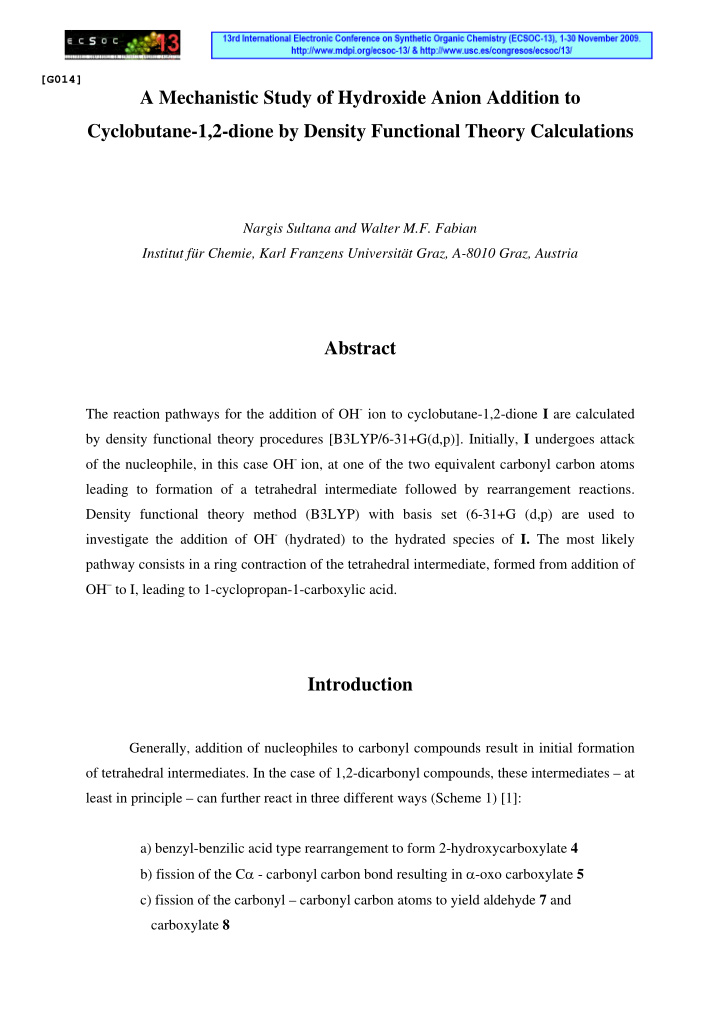



[G014] A Mechanistic Study of Hydroxide Anion Addition to Cyclobutane-1,2-dione by Density Functional Theory Calculations Nargis Sultana and Walter M.F. Fabian Institut für Chemie, Karl Franzens Universität Graz, A-8010 Graz, Austria Abstract The reaction pathways for the addition of OH - ion to cyclobutane-1,2-dione I are calculated by density functional theory procedures [B3LYP/6-31+G(d,p)]. Initially, I undergoes attack of the nucleophile, in this case OH - ion, at one of the two equivalent carbonyl carbon atoms leading to formation of a tetrahedral intermediate followed by rearrangement reactions. Density functional theory method (B3LYP) with basis set (6-31+G (d,p) are used to investigate the addition of OH - (hydrated) to the hydrated species of I. The most likely pathway consists in a ring contraction of the tetrahedral intermediate, formed from addition of OH – to I, leading to 1-cyclopropan-1-carboxylic acid. Introduction Generally, addition of nucleophiles to carbonyl compounds result in initial formation of tetrahedral intermediates. In the case of 1,2-dicarbonyl compounds, these intermediates – at least in principle – can further react in three different ways (Scheme 1) [1]: a) benzyl-benzilic acid type rearrangement to form 2-hydroxycarboxylate 4 b) fission of the C α - carbonyl carbon bond resulting in α -oxo carboxylate 5 c) fission of the carbonyl – carbonyl carbon atoms to yield aldehyde 7 and carboxylate 8
Scheme 1 O O O O RCHO + - + - HO R C C R RCO 2 R C C R 7 OH 8 1 2 O O O - + R H R C RCO 2 HO C R C 2 5 6 3 O OH C C R O 2 4 Depending on the nature of the substituent R all three possibilities, at least formally, have been observed. Note, that for cyclic 1,2-dicarbonyl compounds pathway a) results in a ring contraction (structure III in Scheme 2). Scheme 2 H O - O O + OH - O O II I Case1 Case2 OH COOH - O O O OH - CO - IIIb O III IIIa In extension of our previous study dealing with ab initio and DFT calculation on the mechanism of addition reaction of hydroxide ion to cyclobut-3-ene-1, 2-diones [2] , here we present computational results for the addition of hydroxide ion to the saturated analogue
cyclobutan-1,2-dione. We carried out the calculation of OH – with a solvent cluster of four water molecules, in addition to two water molecules for hydration of I . Computational Details The calculations were carried out by the Gaussian 03 [3] program package. The geometries were completely optimized at Becke’s three-parameter hybrid density functional-HF method with the Lee-Yang-Parr correlation functional (B3LYP) [4] using 6-31+G (d, p) basis set. All transition states characterization has been done by vibrational frequency calculations at the same level of theory and basis set used for geometry optimization. Moreover the transition states were confirmed by intrinsic reaction coordinate (IRC) calculations [5] . Results and Discussions Reaction 1, I(H 2 O) 2 + [(OH)(H 2 O) 4 ] – → TS1 → II → TS2 → III proceeds via formation of an ion-dipole complex ( Ia in Fig. 3), addition of the nucleophile to cyclobutan-1,2-dione via transition state TS1 to the tetrahedral intermediate ( II ) . Calculated structures are displayed in Fig. 1. Figure 1 I(H 2 O) 2 + [(OH – )(H 2 O) 4 ] TS1 II
This intermediate further reacts by by rearrangement via TS2 to the ring-contracted 1- hydroxycyclopropan-1-carboxylate III [1, 6], Fig. 2. Formation of III was found to occur directly from II without any ring-opened intermediate, e.g. IIIa (Scheme 2). Figure 2 TS2 III Our study shows that case 1, i.e. the benzilic acid type rearrangement leading to the ring- contracted cyclopropane carboxylic acid derivative III should be the preferred reaction of I . So far, no transition state for breaking the bond between the two oxygen-bearing carbon atoms (case 2 in Scheme 2) could be located. References [1] K. Bowden, W. M. Fabian, J. Phys. Org. Chem. 14, 794 (2001) [2] M. Uhlar, and W. M. F. Fabian, ECCC9, Poster 18 (2003) [3] Gaussian 03, Revision B.04, M. J. Frisch, G. W. Trucks, H. B. Schlegel, G. E. Scuseria, M. A. Robb, J. R. Cheeseman, J. A.Montgomery, J. T. Vreven, K. N. Kudin, J. C. Burant, J. M. Millam, S. S. Iyengar, J. Tomasi, V. Barone, B. Mennucci, M. Cossi, G. Scalmani, N. Rega, G. A. Petersson, H. Nakatsuji, M. Hada, M. Ehara, K. Toyota, R. Fukuda, J. Hasegawa, M. Ishida, T. Nakajima, Y. Honda, O. Kitao, H. Nakai, M. L. X. Klene, J. E. Knox, H. P. Hratchian, J. B. Cross, C. Adamo, J. Jaramillo, R. Gomperts, R. E. Stratmann, O. Yazyev, A. J. Austin, R. Cammi, C. Pomelli, J. W. Ochterski, P. Y. Ayala, K. Morokuma, G. A. Voth, P. Salvador, J. J.Dannenberg, V. G. Zakrzewski, S. Dapprich, A. D. Daniels, M. C. Strain, O. Farkas, D. K. Malick, A. D. Rabuck, K. Raghavachari, J. B Foresman, J. V. Ortiz,
Q. Cui, A. G. Baboul, S. Clifford, J. Cioslowski, B. B. Stefanov, G. Liu, A. Liashenko, P. Piskorz, I. Komaromi, R. L. Martin, D. J. Fox, T. Keith, M. A. Al-Laham, C. Y. Peng, A. Nanayakkara, M. Challacombe, P. M. W. Gill, B. Johnson, W. Chen, M. W. Wong, C. Gonzalez, J. A. Pople, Gaussian, Inc., Pittsburgh PA, (2003). [4] (a) A. D. Becke, J. Chem. Phys. 98, 5648 (1993). (b) C. Lee, Y.Yang, R. G. Parr, Phys. Rev. B 37, 785 (1998) [5] (a) C. Gonzalez and H. B. Schlegael, J. Phys. Chem. 94, 5523 (1990). (b) C. Gonzalez and H. B. Schlegel, J. Phys. Chem. 90, 2154 (1989) [6] S. Yamabe, N. Tsuchida, S. Yamazaki, J. Org. Chem. 71, 1777 (2006)
Recommend
More recommend